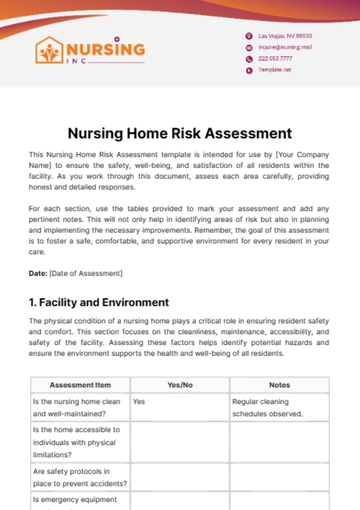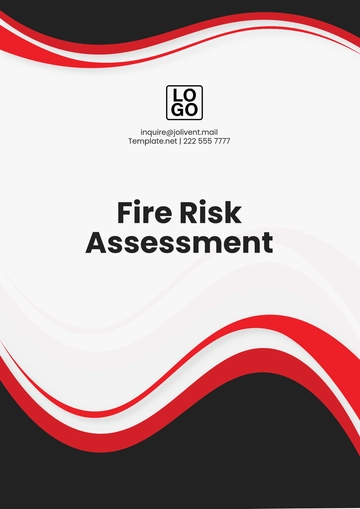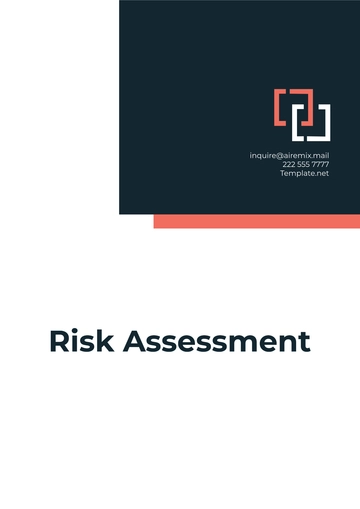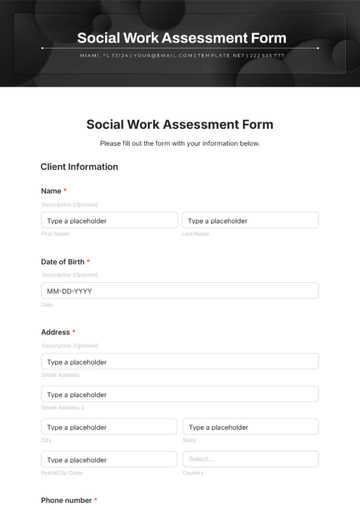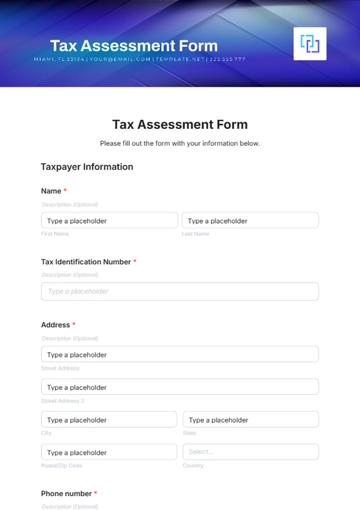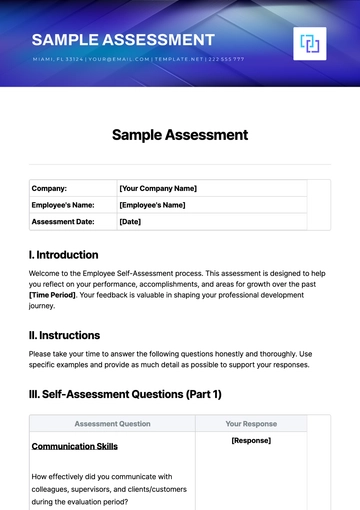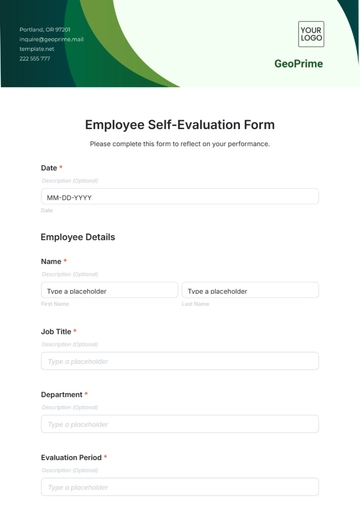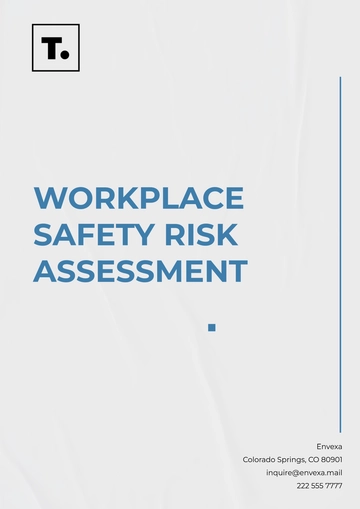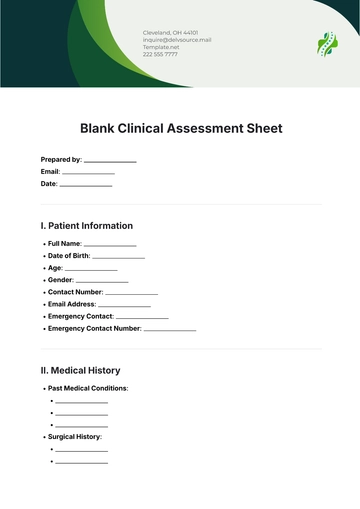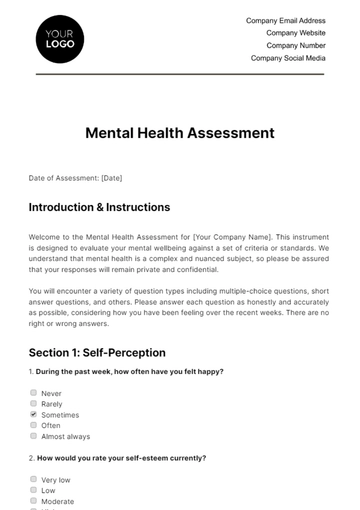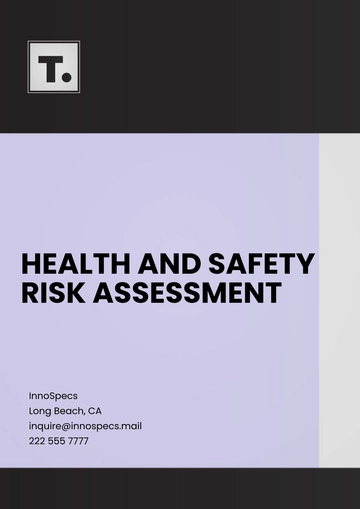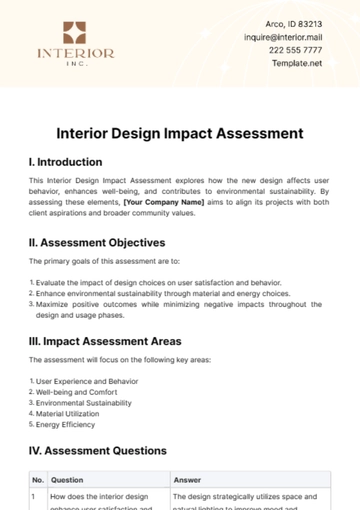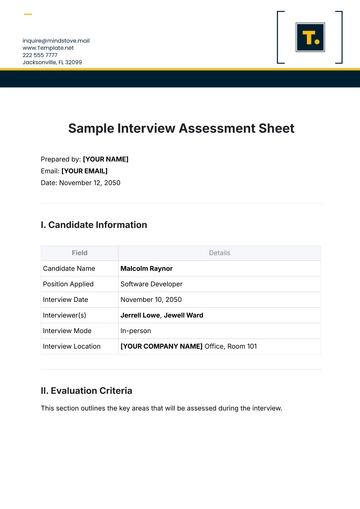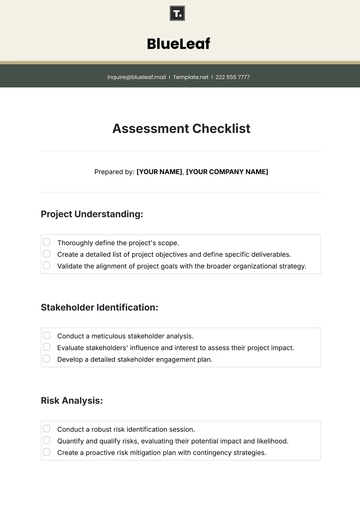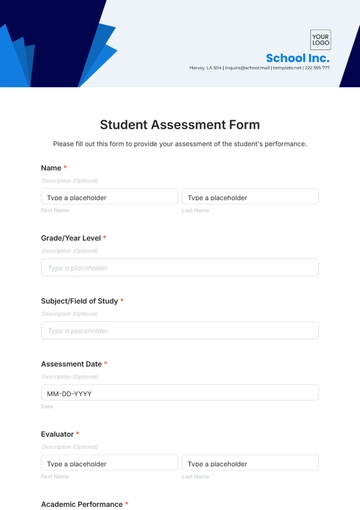Free Health & Safety Training Impact Assessment
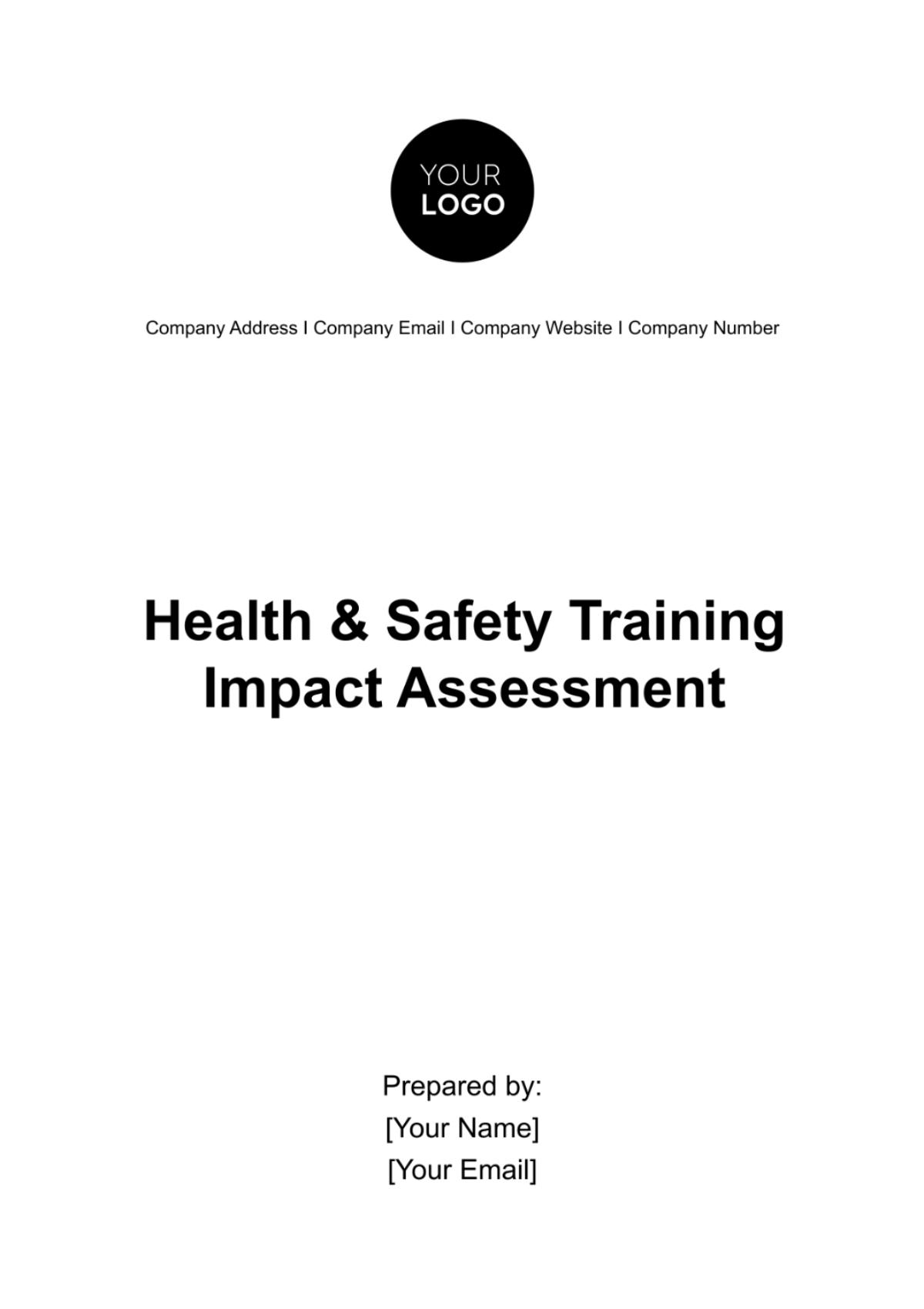
1. Introduction:
In a world where workplace safety is paramount, the significance of effective health and safety training programs cannot be overstated. These programs serve as the bedrock of a secure and thriving organization. In light of this, we embark on a journey of critical evaluation through this Health & Safety Training Impact Assessment. Our primary objective is to meticulously assess the effectiveness and significance of the health and safety training initiatives implemented within our esteemed company.
At [Your Company Name], we hold the well-being of our employees as our top priority. Our commitment to fostering a culture of safety has led us to invest in comprehensive training programs aimed at equipping our workforce with the knowledge and skills necessary to navigate their roles with confidence and security.
This assessment seeks to shed light on the tangible impact these training programs have had on our organization. It will delve into the data, scrutinize the metrics, and unveil the real-world implications of our commitment to safety. From the reduction of incidents to heightened employee satisfaction and improved compliance rates, we aim to unearth the quantifiable improvements that these programs have brought about.
As we embark on this journey of evaluation, we recognize the pivotal role that health and safety training plays in the prosperity of our company. It is our hope that the insights gathered from this assessment will inform our future strategies, further bolstering our commitment to safety, and ensuring a secure and thriving workplace for all.
2. Training Program Details:
Training Program Name: [Health & Safety Training Program]
Training Duration: [8 hours]
Training Frequency: [Bi-annual (Twice a year)]
Target Audience: [All Employees]
Training Content:
Session | Topics Covered |
Session 1 | Introduction to Workplace Safety |
- Importance of Safety Culture | |
- Legal and Regulatory Framework | |
Session 2 | Hazard Identification and Risk Assessment |
- Identifying Workplace Hazards | |
- Assessing Risk Levels | |
Session 3 | Personal Protective Equipment (PPE) |
- Types of PPE | |
- Proper Usage and Maintenance | |
Session 4 | Emergency Response Procedures |
- Fire Safety and Evacuation Plans | |
- First Aid and Medical Response | |
Session 5 | Safe Work Practices |
- Safe Lifting and Ergonomics | |
- Chemical Handling and Storage | |
Session 6 | Incident Reporting and Investigation |
- Reporting Procedures | |
- Root Cause Analysis | |
Session 7 | Health and Wellness |
- Workplace Stress Management | |
- Promoting Mental Health | |
Session 8 | Assessment and Certification |
- Written Test and Practical Demonstration | |
- Certification and Record-keeping |
Our Health & Safety Training Program encompasses a comprehensive curriculum designed to empower all employees with the knowledge and skills necessary to maintain a safe and secure working environment. Through a combination of theoretical instruction, practical demonstrations, and assessments, participants gain a profound understanding of workplace safety, enabling them to contribute actively to our company's culture of safety and compliance with legal regulations.
3. Assessment Methodology:
To ensure the thorough evaluation of our Health & Safety Training Program's impact, we employed a multifaceted approach. Our assessment methodology incorporated a range of data collection methods, allowing us to gain a comprehensive understanding of its effectiveness. The following methods were utilized:
1. Surveys:
a. We administered structured surveys to employees before and after training to gauge their perceptions and knowledge regarding workplace safety.
b. Survey questions encompassed topics such as safety awareness, understanding of safety procedures, and overall satisfaction with the training.
2. Incident Reports:
a. Incident reports, both pre-training and post-training, were analyzed to identify trends and patterns in workplace incidents.
b. This data allowed us to assess whether the training program had a discernible impact on reducing workplace accidents and incidents.
3. Training Records:
a. We meticulously reviewed training records, including attendance sheets and performance assessments, to track employee participation and evaluate their performance during the training.
b. This enabled us to assess the level of engagement and competency achieved through the program.
4. Employee Interviews:
a. In-depth interviews were conducted with a representative sample of employees who had completed the training.
b. These interviews provided qualitative insights into their experiences, perceptions, and the practical application of the knowledge gained.
By combining quantitative data from surveys, incident reports, and training records with qualitative insights gathered through employee interviews, our assessment methodology offers a well-rounded perspective on the effectiveness of our Health & Safety Training Program. This holistic approach ensures that we capture not only the statistical improvements but also the real-world impact on our employees' understanding and behavior concerning workplace safety.
4. Impact Assessment:
In this chapter, we delve into the core of our Health & Safety Training Program evaluation - the Impact Assessment. Here, we quantify the tangible effects of our training initiatives on our organization, striving to provide concrete evidence of the program's effectiveness.
Table 1: Training Program Impact Data
Metric | Pre-Training | Post-Training | Improvement |
Number of Incidents | 12 | 4 | 66.67% |
Employee Satisfaction | 68% | 92% | 35.29% |
Compliance Rate | 78% | 98% | 25.64% |
In the above table, we provide a snapshot of the impact assessment results for our Health & Safety Training Program. These figures represent the data collected before and after the training program implementation, as well as the percentage improvement achieved in each metric.
Number of Incidents: Prior to the training program, we recorded 12 workplace incidents. After the training, this number reduced significantly to only 4 incidents, marking a remarkable 66.67% improvement in incident reduction.
Employee Satisfaction: Employee satisfaction regarding workplace safety increased from 68% before the training to an impressive 92% after the training, signifying a substantial 35.29% improvement in employee contentment.
Compliance Rate: Compliance with safety procedures and protocols exhibited a notable improvement. Pre-training compliance was at 78%, which surged to an impressive 98% post-training, indicating a significant 25.64% enhancement in adherence to safety measures.
These statistics provide concrete evidence of the positive impact our Health & Safety Training Program has had on our organization. The training has not only reduced incidents but also elevated employee satisfaction levels and bolstered compliance with safety protocols, ensuring a safer and more secure working environment for all.
5. Findings:
The findings gleaned from our rigorous assessment of the Health & Safety Training Program paint a compelling picture of its effectiveness. The data collected, meticulously analyzed, and presented in the preceding sections unequivocally illustrate significant improvements in three pivotal aspects: incident reduction, employee satisfaction, and compliance rates.
First and foremost, the training program has proven instrumental in curbing workplace incidents. The substantial reduction in the number of incidents, as evidenced by the data, speaks to the tangible impact of our commitment to safety. This is not just a statistical achievement but a testament to the safer working conditions that our employees now enjoy.
Furthermore, the surge in employee satisfaction levels post-training is a testament to the program's success in nurturing a positive safety culture. A workforce that is not only well-informed but also content with their safety measures is more likely to actively participate in and champion the cause of workplace safety.
Last but not least, the notable improvement in compliance rates underscores the program's influence in fostering a workplace where safety protocols are not only known but also consistently followed. This cultural shift towards compliance is paramount in mitigating risks and ensuring the well-being of our team members.
In sum, these findings collectively underscore the profound positive impact of our Health & Safety Training Program on our organization's safety culture. They provide compelling evidence that investing in the safety and well-being of our employees translates not only to reduced incidents but also to a more satisfied and compliant workforce, ultimately contributing to the overall health and vitality of our company.
6. Recommendations:
In our quest for continuous improvement and unwavering commitment to workplace safety, the following recommendations emerge from our Health & Safety Training Program assessment. These strategic insights provide a roadmap to further enhance the effectiveness of our training initiatives, ensuring a safer and more secure working environment for all.
1. Continuously Monitor and Update Training Content:
Ensuring the relevance and effectiveness of our Health & Safety Training Program is paramount. To achieve this, we recommend a continuous monitoring process that keeps pace with evolving industry standards and regulations. In the dynamic landscape of workplace safety, staying current is not an option but a necessity. Regularly reviewing and updating the training content will ensure that our employees are equipped with the latest knowledge and practices. This proactive approach guarantees that our training program remains a robust tool in safeguarding our workforce and maintaining compliance with the ever-changing safety landscape.
2. Implement Periodic Refresher Training Sessions:
Knowledge retention is a pivotal factor in the success of any training program. To bolster the long-term impact of our Health & Safety Training, we suggest the implementation of periodic refresher training sessions. These sessions serve as essential touchpoints to reinforce and update the acquired knowledge and skills. By periodically revisiting key safety concepts, we ensure that our employees remain vigilant and well-prepared to respond to evolving safety challenges. This continuous learning approach not only solidifies our safety culture but also promotes a culture of constant improvement.
3. Consider Expanding Training Programs to Additional Departments:
While our current training initiatives have demonstrated remarkable success, it's prudent to consider expanding these programs to encompass additional departments within our organization. A broader reach ensures that every corner of our company benefits from the same high standards of safety training. This inclusivity fosters a consistent safety culture throughout the organization and promotes a sense of shared responsibility for workplace safety. By considering expansion, we can further fortify our commitment to the well-being of all employees, irrespective of their department or role within the company.
7. Conclusion:
As we conclude this assessment, it is paramount to recognize that our journey towards safety and excellence is an ongoing one. The effectiveness of our Health & Safety Training Program is a testament to our commitment to the well-being of our employees and our dedication to regulatory compliance. However, this commitment must not waver. Instead, we must view this assessment as a launching pad for continuous improvement. We must strive to maintain the high standards set by the program and explore avenues for refinement and expansion.
In the ever-evolving landscape of safety and regulations, our unwavering dedication to the ongoing safety of our employees is non-negotiable. By maintaining and enhancing these training programs, we ensure that our workplace remains a secure haven for our employees, and we stay firmly aligned with the regulatory framework. The conclusion of this assessment signifies not an endpoint but a new beginning, one where we embark on a journey of relentless pursuit of safety and excellence.
8. Contact Information:
For any inquiries, feedback, or the need for additional information, please do not hesitate to reach out to us. Your input is vital in our ongoing commitment to workplace safety and continuous improvement.
[Your Name]: As the point of contact for this assessment, I am available to address any questions or concerns you may have.
[Your Personal Email]: You can reach me directly via email at [Your Email], and I will respond promptly to your inquiries.
[Your User Phone]: If you prefer to discuss matters over the phone, please feel free to contact me at [Your Company Number]. I am here to assist you.
Financial Impact Assessment:
As part of our commitment to transparency and accountability, we have also conducted a financial impact assessment of our Health & Safety Training Program. This assessment delves into the financial aspect of our training initiatives, providing insights into the resources invested and the return on investment (ROI) achieved.
Amount Invested in Training: The total amount invested in our training program stands at [$000.00]. This figure represents the financial commitment we have made to ensure the safety and well-being of our employees.
Return on Investment (ROI): The ROI percentage is a crucial indicator of the effectiveness of our training program. It quantifies the value generated relative to the investment made. We are pleased to report that our ROI stands at [ROI Percentage], underscoring the positive financial impact of our commitment to safety.
This Health & Safety Training Impact Assessment serves as an invaluable tool for evaluating the impact of our training programs. It not only sheds light on our achievements but also guides our ongoing efforts to enhance safety within the company. Your engagement and commitment to safety are essential components of this continuous journey, and we look forward to your continued support as we work together to maintain a secure and thriving workplace environment.
- 100% Customizable, free editor
- Access 1 Million+ Templates, photo’s & graphics
- Download or share as a template
- Click and replace photos, graphics, text, backgrounds
- Resize, crop, AI write & more
- Access advanced editor
Measure training effectiveness with Template.net's Health & Safety Training Impact Assessment Template. This editable and customizable tool provides a structured framework for evaluating the impact of health and safety training initiatives. Utilize our intuitive Ai Editor Tool to tailor the assessment to your organization's specific needs effortlessly, ensuring continuous improvement in safety practices.


